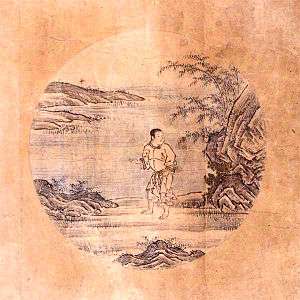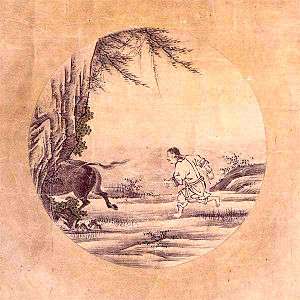Ten Bulls

Ten Bulls or Ten Ox Herding Pictures (十牛; Japanese: jūgyū, Chinese: shíniú) is a series of short poems and accompanying pictures used in the Zen tradition to illustrate the stages of a practitioner's progression towards the purification of the mind and enlightenment,[web 1] as well as his or her subsequent return into the world while acting out of wisdom.
History
.png)
The calf, bull or ox is one of the earliest similes for meditation practice. It comes from the Maha Gopalaka Sutta (Majjhima Nikaya 33). It is also used in the commentaries, especially the one on the Maha Satipahna Sutta (Digha Nikaya 22) and the Satipahna Sutta (Majjhima Nikaya 10).[web 2] With the spread of Buddhism throughout South-East Asia, the simile of the bull also spread.[web 2]
The well-known ten ox-herding pictures emerged in China in the 12th century. D.T. Suzuki[web 3] mentions four Chinese versions of the Oxherding Pictures, by Ching-chu (Jp. Seikyo)(11th century),[web 4] Tzu-te Hui (Jp. Jitoku)(1090-1159),[web 4] an unknown author, and Kuòān Shīyuǎn (Jp. Kaku-an) (12th century).[web 3] The best-known of these is the version by Kuòān Shīyuǎn.[web 3]
Probably the first series was made by Ching-chu (清居, Jp. Seikyo) (11th century),[web 4] who may have been a contemporary of Kuòān Shīyuǎn. In Ching-chu's version only five pictures are being used, and the ox's colour changes from dark to white, representing the gradual development of the practitioner, ending in the disappearance of the practitioner.[web 3]
Tzu-te Hui (自得慧暉, Zide Huihui, Jp. Jitoku) (1090-1159)[web 4] made a version with six pictures. The sixth one goes beyond the stage of absolute emptiness, where Ching-chu's version ends. Just like Ching-chu's version, the ox grows whiter along the way.[web 3][note 1]
A third version by an unknown author, with ten pictures, was most popular in China.[web 3] It belongs to the Ching-chu and Tzu-te Hui series of pictures,[web 3] and has a somewhat different serie of pictures compared to Kuòān Shīyuǎn's version.[web 5] The 1585-edition contains a preface by Chu-hung, and it has ten pictures, each of which is preceded by Pu-ming's poem, of whom Chu-hung furtherwise provides no information. In this version too the ox's colour changes from dark to white.[web 3][note 1]
The best known version of the oxherding pictures was drawn by the 12th century Chinese Rinzai Chán (Zen) master Kuòān Shīyuǎn (廓庵師遠, Jp. Kaku-an Shi-en), who also wrote accompanying poems and introductory words attached to the pictures.[web 3] In Kuòān Shīyuǎn's version there is no whitening process, [web 3] and his series also doesn't end with mere emptiness, or absolute truth, but shows a return to the world, depicting Putai, the laughing Buddha.[web 3] According to Chi Kwang Sunim, they may also represent a Zen Buddhist interpretation of the ten Bodhisattva bhumi, the ten stages on the Bodhisattva-path.[web 6]
In Japan, Kuòān Shīyuǎn's version gained a wide circulation, the earliest one probably belonging to the fifteenth century.[web 3] They first became widely known in the West after their inclusion in the 1957 book, Zen Flesh, Zen Bones: A Collection of Zen and Pre-Zen Writings, by Paul Reps and Nyogen Senzaki.
Liaoan Qingyu (了菴清欲, Jp. Ryōan Seiyoku) (1288-1363) made another version with five pictures.[web 7]
Kuòān Shīyuǎn's Ten Bulls
Verses by Kuòān Shīyuǎn;[web 4] translation by Senzaki Nyogen (千崎如幻) (1876–1958) and Paul Reps (1895-1990);[web 4] paintings traditionally attributed to Tenshō Shūbun (天章周文) (1414-1463).[web 8]
-

1. In Search of the Bull
In the pasture of the world,
I endlessly push aside the tall
grasses in search of the Ox.
Following unnamed rivers,
lost upon the interpenetrating
paths of distant mountains,
My strength failing and my vitality exhausted, I cannot find the Ox. -

2. Discovery of the Footprints
Along the riverbank under the trees,
I discover footprints.
Even under the fragrant grass,
I see his prints.
Deep in remote mountains they are found.
These traces can no more be hidden
than one's nose, looking heavenward.[web 1] -

3. Perceiving the Bull
I hear the song of the nightingale.
The sun is warm, the wind is mild,
willows are green along the shore -
Here no Ox can hide!
What artist can draw that massive head,
those majestic horns?[web 1] -

4. Catching the Bull
I seize him with a terrific struggle.
His great will and power
are inexhaustible.
He charges to the high plateau
far above the cloud-mists,
Or in an impenetrable ravine he stands.[web 1] -

5. Taming the Bull
The whip and rope are necessary,
Else he might stray off down
some dusty road.
Being well-trained, he becomes
naturally gentle.
Then, unfettered, he obeys his master.[web 1] -

6. Riding the Bull Home
Mounting the Ox, slowly
I return homeward.
The voice of my flute intones
through the evening.
Measuring with hand-beats
the pulsating harmony,
I direct the endless rhythm.
Whoever hears this melody
will join me.[web 1] -

7. The Bull Transcended
Astride the Ox, I reach home.
I am serene. The Ox too can rest.
The dawn has come. In blissful repose,
Within my thatched dwelling
I have abandoned the whip and ropes.[web 1] -

8. Both Bull and Self Transcended
Whip, rope, person, and Ox -
all merge in No Thing.
This heaven is so vast,
no message can stain it.
How may a snowflake exist
in a raging fire.
Here are the footprints of
the Ancestors.[web 1] -

9. Reaching the Source
Too many steps have been taken
returning to the root and the source.
Better to have been blind and deaf
from the beginning!
Dwelling in one's true abode,
unconcerned with and without -
The river flows tranquilly on
and the flowers are red.[web 1] -

10. Return to Society
Barefooted and naked of breast,
I mingle with the people of the world.
My clothes are ragged and dust-laden,
and I am ever blissful.
I use no magic to extend my life;
Now, before me, the dead trees
become alive.[web 1]
Cite error: There are <ref group=web> tags on this page, but the references will not show without a {{reflist|group=web}} template (see the help page).
Reception
Chan Buddhism
The ox-herding pictures had an immediate and extensive influence on the Chinese practice of Chan Buddhism.[1]
Western reception
In the West, they were eventually to influence the work of John Cage, particularly in his emphasis on rhythmic silence, and on images of nothingness.[2] At the same time, through the last picture especially - 'In the Marketplace' – they have provided a conceptual umbrella for those Buddhists seeking a greater engagement with the post-industrial global marketplace.[3]
Ten Elephants
An equivalent series of stages is depicted in the Nine Stages of Tranquility,[web 2] used in the Mahamudra tradition, in which the mind is represented by an elephant and a monkey.[web 9][web 10][note 2][note 3] The Dharma Fellowship', a Kagyu (Mahamudra) organisation, notes that the practice starts with studying and pondering the dharma, where-after the practice of meditation commences.[web 11]
See also
Notes
- 1 2 See Terebess Asia Online, Three Oxherding Versions Compared
- ↑ This formulation originates with Asaṅga (4th CE), delineating the nine mental abidings in his Abhidharmasamuccaya and the Śrāvakabhūmi chapter of his Yogācārabhūmi-śāstra. It is also found in the Mahāyānasūtrālaṅkāra of Maitreyanātha, which shows considerable similarity in arrangement and content to the Bodhisattva-bhūmi-śāstra.
- ↑ Piya Tan gives a full description of these stages; see Piya Tan (2004), The Taming of the Bull. Mind-training and the formation of Buddhist traditions, dharmafarer.org
References
- ↑ Jinwul 2009, p. 139.
- ↑ Pritchett 1996, p. 60-69.
- ↑ Goodman 1999, p. 352.
Sources
Printed sources
- Goodman, R. A. (1999), Modern Organizations and Emerging Conundrums, Lexington Books
- Jinwol (2009), Seon Experience for Ecological Awakening. In: Religion, Ecology & Gender, pp.131-146, LIT Verlag Münster
- Pritchett, J. (1996), The Music of John Cage, Cambridge University Press
Web-sources
- ↑ 廓庵《十牛圖頌》考:從牧牛圖頌談起
- 1 2 3 Piya Tan (2004), The Taming of the Bull. Mind-training and the formation of Buddhist traditions, dharmafarer.org
- 1 2 3 4 5 6 7 8 9 10 11 12 D.T. Suzuki, The Ten Oxherding Pictures
- 1 2 3 4 5 6 Terebess Online, Oxherding Pictures Index
- ↑ Terebess Asia Online, Three Oxherding Versions Compared
- ↑ Venerable Chi Kwang Sunim, Ten Bulls, Ten Bhumis, Buddhist Summer Scholl 2013
- ↑ terebess, Five Oxherding Verses
- ↑ therebess, Harada Shōdō commentary
- ↑ Dharma Fellowship, Deepening Calm-Abiding - The Nine Stages of Abiding
- ↑ Skyflower Dharmacenter, Mahamudra Tranquility and Insight
- ↑ Dharma Fellowship, Deepening Calm-Abiding - The Nine Stages of Abiding
- Reverend Eshin, Ten Oxherding Pictures
Further reading
- Background
- Rahula, Walpola (1978), Zen and the Taming of the Bull: Towards the Definition of Buddhist Thought, Gordon Fraser Book Publishers
- Tan, Pia (2004), The Taming of the Bull. Mind-training and the formation of Buddhist traditions (PDF)
- Commentaries
- Yamada, Mumon (2004), Lectures On The Ten Oxherding Pictures, University of Hawaii Press
- Samy, AMA (2005), Zen: Awakening to Your Original Face, Cre-A
- Shibayama, Zenkei (2012), A Flower Does Not Talk: Zen Essays, Tuttle Publishing
- Daido Loori, John (2013), The Eight Gates of Zen: A Program of Zen Training, Shambhala Publications
External links
- General
- Terebess Online, Oxherding Pictures Index, huge collection of resources on the oxherding pictures
- Zide Huihui (Jp. Jitoku Keiki) (1090-1159) version (six pictures)
- Chinese Pu-Ming (Jp. Fumyō) version (ten pictures)
- Kuòān Shīyuǎn (12th century) version (ten pictures)
- Paul Reps (1957), Zen Flesh, Zen Bones: A Collection of Zen and Pre-Zen Writings
- Reverend Eshin, Ten Oxherding Pictures
- John M. Koller, Ox-herding: stages of Zen-practice
- Extended commentaries
- Commentary by D.T. Suzuki
- Commentary by Shodo Harada
- Commentary by Sheng Yen
- Commentary by Ruben Habito
- Commentary by Martine Batchelor
- Commentary by Chögyam Trungpa
- Commentary by Jeff Shore and Bernadette Roberts
- Taming the Elephant
- Dharma Fellowship, Deepening Calm-Abiding - The Nine Stages of Abiding
- Skyflower Dharmacenter, Mahamudra Tranquility and Insight
- Comparison of the Elephant and the Ox (dead link)
- Other
- A comparison between the Zen Buddhist Ten Oxherding Pictures and the Theory of Positive Disintegration
- Dward Muzika, Awakening versus Liberation